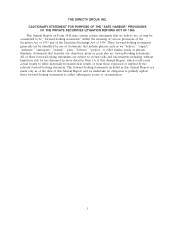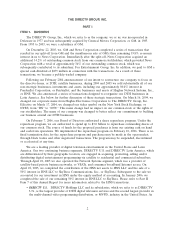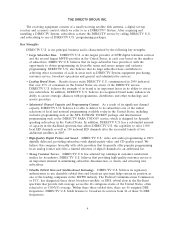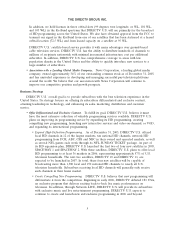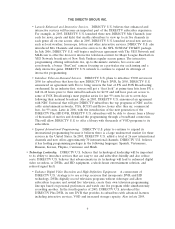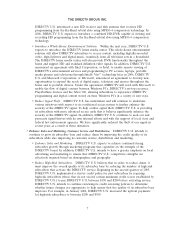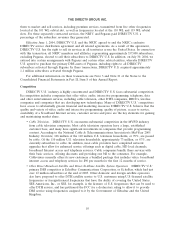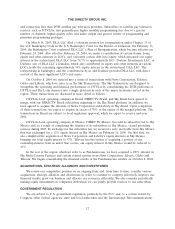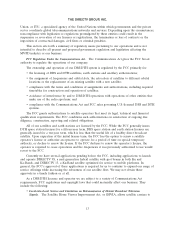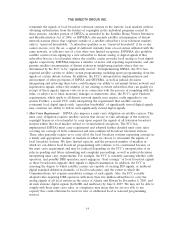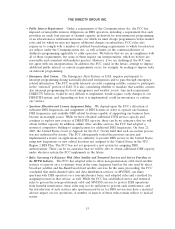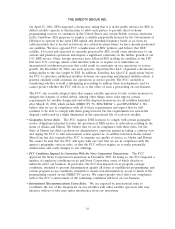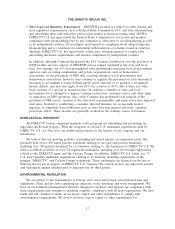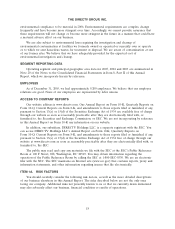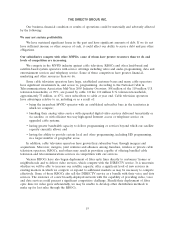DIRECTV 2005 Annual Report Download - page 24
Download and view the complete annual report
Please find page 24 of the 2005 DIRECTV annual report below. You can navigate through the pages in the report by either clicking on the pages listed below, or by using the keyword search tool below to find specific information within the annual report.THE DIRECTV GROUP, INC.
•Regional Bell Operating Companies. Several RBOCs have started to upgrade their infrastructure
by replacing their older copper wire telephone lines with high-speed fiber optic lines. These fiber
lines provide the RBOCs with significantly greater capacity enabling them to offer new and
enhanced services, such as Internet access at much greater speeds and video. For example,
AT&T Inc., formerly known as SBC Communications Inc., announced plans and has begun to
deploy fiber optic lines to neighborhoods serving approximately 18 million of its customers by
2008, and Verizon announced a target to upgrade to fiber optic lines for six million customer
homes by the end of 2006 with the long-term goal of upgrading 18 million homes. Similar to the
cable companies, the RBOCs expect to offer their customers multiple services at a discount on
one bill. AT&T recently agreed to acquire BellSouth Corporation, which could affect our
marketing relationship with BellSouth.
•Video via the Internet. With the large increase in the number of consumers with broadband
service, a significant amount of video content has become available on the Internet for users to
download and view on their personal computers and other devices. For example, Google Inc. has
launched an online video service offering a wide variety of both free and pay-per-view content,
and Starz Entertainment Group LLC, a provider of movie services to MVPD providers,
launched an Internet-based movie subscription service that will offer users unlimited access to
more than 850 movies and other programs for $9.99 a month. In addition, there are several
initiatives by companies such as Intel and Microsoft to make it easier to view Internet-based
video on television and personal computer screens.
•Terrestrial Wired and Wireless Providers. Broadband services providers, wireless systems, portable
handheld devices and satellite master antenna television systems currently offer or could offer in
the future MVPD and program distribution technologies in competition with DIRECTV U.S.
For example, in 2005, Apple Computer Inc., or Apple, introduced a service where customers can
download various ABC and NBC television shows the day after they air on television to Apple’s
portable iPod↦ device for $1.99.
•VHF/UHF Broadcasters. Most areas of the United States can receive traditional terrestrial
VHF/UHF television broadcasts of between three and ten channels. These broadcasters are
often low to medium power operators with a limited coverage area and provide local, network
and syndicated programming typically free of charge. The FCC has allocated additional digital
spectrum to licensed broadcasters. At least during a transition period, each existing television
station will be able to retain its present analog frequencies and also transmit programming on a
digital channel that may permit multiple programming services per channel.
DIRECTV LATIN AMERICA
DTVLA is a leading provider of digital DTH digital television services throughout Latin America,
which includes South America, Central America, and the Caribbean. DTVLA provides a wide selection
of high-quality local and international programming under the DIRECTV brand to approximately
1.6 million subscribers in 27 countries throughout the region of which approximately 85% are located in
Brazil, Argentina, Venezuela and Puerto Rico. The pay television and other emerging broadband video
and data markets in Latin America are highly competitive. In each of DTVLA’s markets, it competes
primarily with other providers of pay television, who distribute their programming by cable, terrestrial
microwave systems, traditional over the air broadcasting or DTH satellite pay television. DTVLA
competes primarily on the basis of programming selection, price, technology and quality. In most of the
markets in which DTVLA operates, cable services have been in commercial operation longer than
other pay television platforms, and have established large subscriber bases and widespread brand
recognition. Cable operators are also generally able to offer their subscribers lower upfront installation
11


